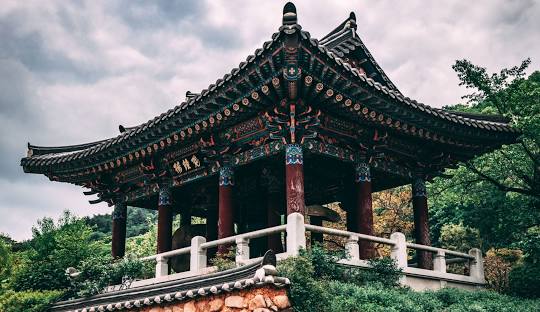Gyeongju, South Korea
🏛️ Gyeongju, South Korea – The Historical Heart of the Silla Kingdom
Gyeongju is often referred to as "the museum without walls" because of its rich historical and cultural significance. Once the capital of the Silla Kingdom, it is home to ancient palaces, temples, royal tombs, and cultural landmarks. A visit to Gyeongju feels like stepping back in time to the heyday of one of Korea's oldest kingdoms.
🏰 Top Attractions in Gyeongju
🏯 1. Bulguksa Temple – A UNESCO World Heritage Site
-
Historic Significance: Bulguksa Temple, a UNESCO World Heritage Site, is one of the finest examples of Korean Buddhist architecture.
-
Key Features: The temple complex includes the famous Dabotap and Seokgatap pagodas, which are important national treasures.
-
Tip: The temple is particularly stunning during the fall when the surrounding trees change color.
⚰️ 2. Tumuli Park (Daereungwon Tomb Complex) – Ancient Royal Tombs
-
Royal Burial Site: Tumuli Park is home to large ancient tombs of Silla kings and queens. The Cheonmachong Tomb, which means "heavenly horse tomb," is the most famous.
-
Fun Fact: Inside Cheonmachong, a remarkable array of artifacts was discovered, including a saddle, crown, and weapons.
-
Tip: Don’t miss the opportunity to explore the tombs and visit the Gyeongju National Museum nearby to see the relics.
🌾 3. Anapji Pond – Scenic Beauty
-
Peaceful Setting: Anapji Pond is a serene, artificial pond originally built as a palace garden during the Silla Kingdom.
-
Key Features: The pond is beautifully illuminated at night, offering a magical view of the traditional buildings reflected on the water.
-
Tip: Visit in the evening for a more romantic, tranquil experience.
⛩️ 4. Seokguram Grotto – A Monumental Buddhist Shrine
-
Architectural Marvel: Seokguram Grotto is a hermitage housing a magnificent stone Buddha. It was built in the 8th century and is another UNESCO World Heritage Site.
-
Scenic Surrounding: Located on the slopes of Mount Tohamsan, the view surrounding the grotto is just as breathtaking as the Buddha statue itself.
-
Tip: Arrive early to avoid crowds and enjoy the peaceful atmosphere.
🌿 5. Gyeongju National Museum – Gateway to Silla’s History
-
Cultural Insight: The museum showcases a wealth of artifacts, including pottery, coins, and jewelry from the Silla Dynasty, giving a deeper insight into Korea's ancient history.
-
Key Features: The Golden Crown and Silla jewelry are some of the most prized exhibits.
-
Tip: Spend a few hours here to understand the cultural and historical context of Gyeongju.
🏞️ 6. Mount Namsan – A Sacred Mountain for Hiking
-
Sacred Site: Mount Namsan is dotted with Buddhist stone carvings and is an important pilgrimage site.
-
Hiking Trails: The mountain offers scenic trails where you can see stone Buddha statues, pagodas, and other ancient relics.
-
Tip: Hike during the early morning or late afternoon to avoid the heat and crowds.
🌺 7. Gyeongju’s Cherry Blossom Festivals
-
Spring Beauty: Gyeongju is famous for its cherry blossoms in the spring. Bomun Lake, in particular, is the best spot to experience the stunning blooms.
-
Festivities: During the cherry blossom season, the city hosts the Gyeongju Cherry Blossom Festival, with performances, cultural activities, and vibrant scenery.
-
Tip: Visit in early April to catch the cherry blossoms at their peak.
🍲 What to Eat in Gyeongju
-
🐟 Hwangnam Bread – A local sweet pastry filled with red bean paste.
-
🍲 Gyeongju’s Bibimbap – A variation of the traditional bibimbap, often served with seasonal vegetables and beef.
-
🥢 Gyeongju-style Hotteok – A Korean pancake filled with brown sugar, honey, peanuts, and cinnamon.
-
🍚 Sikhye – A traditional Korean sweet rice drink, often served as dessert.
📅 Best Time to Visit Gyeongju
-
🌸 Spring (April): Ideal for cherry blossom viewing, with vibrant festivals and warm weather.
-
🍁 Autumn (October–November): Gyeongju’s ancient sites are surrounded by colorful autumn foliage, making it a perfect time for a scenic visit.
-
🌞 Summer (June–August): Can be warm, but good for exploring the outdoor sites.
-
❄️ Winter (December–February): Quieter and colder, but a peaceful time to explore the historical sites without the crowds.
🚇 Getting Around Gyeongju
-
🚗 Rent a Car: Renting a car is one of the easiest ways to explore Gyeongju, as it offers flexibility to visit historical sites and enjoy scenic routes.
-
🚶♂️ Walking: Many of the historical sites are within walking distance of each other, so walking is a good option.
-
🚌 Public Buses: Gyeongju has a reliable bus network, but renting a car or hiring a guide will allow you to explore at your own pace.
💡 Why Visit Gyeongju?
-
✅ Historical Significance: Explore ancient palaces, tombs, and Buddhist temples.
-
✅ Rich Cultural Heritage: Learn about the Silla Kingdom through artifacts and museums.
-
✅ Scenic Landscapes: Visit beautiful lakes, mountains, and parks.
-
✅ Delicious Local Cuisine: Taste unique regional dishes that have been perfected over centuries.


